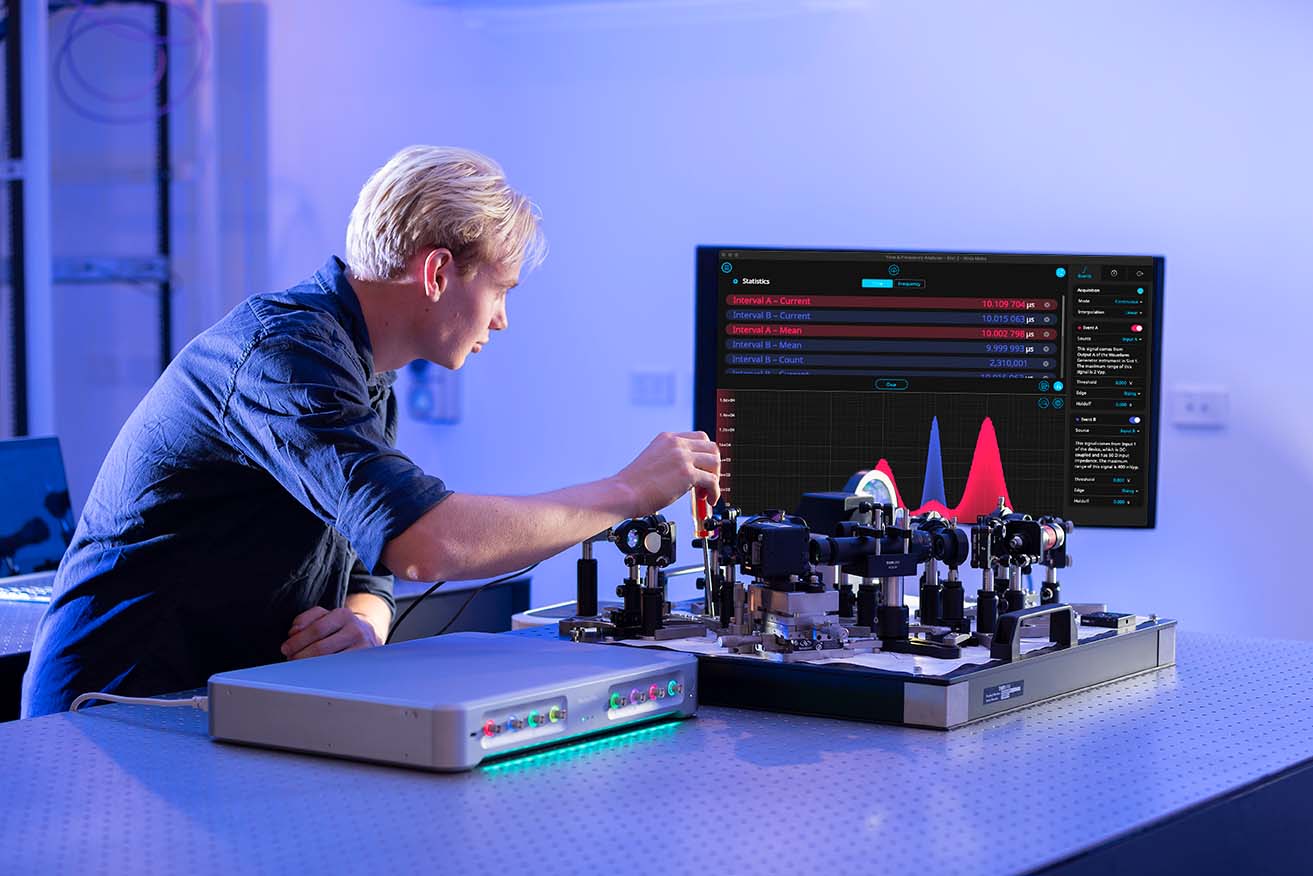Precise photon counting
In photon counting experiments such as Hanbury Brown-Twiss setups, a common challenge is synthesizing and presenting data to detect coincidences or compute g²(𝛕) and higher-order correlation functions, prolonging project timelines. The Moku Time & Frequency Analyzer accelerates data interpretation efficiency with real-time, lossless histograms and interval statistics for live computation of quantum statistics.

Adapt to different photon counting experiments
Reconfigurable Moku devices integrate an entire suite of instruments crucial for single-photon detection and analysis, like the Time & Frequency Analyzer, Phasemeter, and Lock-in Amplifier. Combine instruments in Multi-instrument Mode for system-level characterization and feedback control.
Log photon arrival times for post processing
Log detection intervals and event timestamps at up to 10 Mevnt/s for post-processing with the embedded Data Logger. Classify photons, measure the photon coincidence count rate to extract the second-order correlation, and monitor background signals to extract only meaningful information.
Analyze interval statistics in real time
Statistics like number of counts and mean, minimum, and maximum interval durations are computed in real time so you can view results while adjusting measurement parameters.
View real-time, lossless histograms
Make cumulative measurements to view how many intervals fall in a particular bin without lengthy post-processing data manipulation.

Generate live histograms
Using the Time & Frequency Analyzer, you can watch histograms accumulate with a minimum bin-width of 0.78 ps while performing experiments like time-correlated single-photon counting (TCSPC). Determine fluorescence lifetimes, photon count distribution, and measure g²(𝛕) functions in real time. Not sure how to configure your setup? View the configurations to get started.
Engineered for real-time quantum statistics
With Moku:Pro, you have access to multiple pieces of advanced optics instrumentation in one device. Deployed standalone or in Multi-instrument Mode, the Time & Frequency Analyzer and Phasemeter, and Spectrum Analyzer cover applications such as:
- Dark matter detection
- Fiber-optic communication
- Hanbury Brown-Twiss (HBT) experiments
- Medical imaging
- Quantum optics
.gif)

Build custom signal processing pipelines
The FPGA-based architecture of Moku devices allows you to fully customize test systems in a single device. Build unique test configurations tailored to your experiment without the need for additional instrumentation. Our users tell us that Moku gives us the freedom to experiment, even when they don't know exactly what instruments they'll need.
See how Moku is advancing optical experiments
Compare hardware platforms
Explore Moku hardware options. Compare the instrument specs to choose the right device for your application.

About Liquid Instruments
Most test environments are unique and require customized configuration and careful optimization of multiple instruments, adding cost and time upfront and throughout the test cycle. Liquid Instruments’ reconfigurable Moku is the only test solution that is engineered and optimized for friction-free customization in both simple tests and complex multi-instrument environments. In hundreds of labs around the world, Moku has accelerated the timeline of crossing from idea to implementation by an order of magnitude, reducing the time and cost of advanced research and development. Because our reconfigurable Moku test solutions are engineered by a team of distinguished research scientists to be easy to use and versatile, they deliver efficiency gains in the most complex test scenarios today and meet your ongoing needs in the future. Experience Moku cost-free by requesting a demo today.




.png?width=1054&height=1054&name=Untitled%20design%20(1).png)


